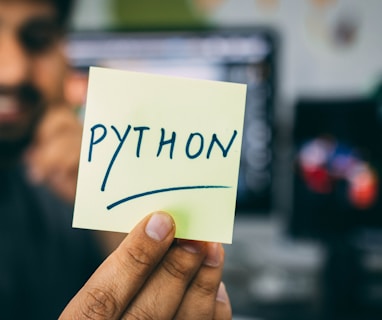Learning Python for Data Science from Zero (Part I — Baby to Beginner Level)
Sharing from a finance professional who has established an AI startup.
ENGLISH ARTICLES
Hudson Ko
2/22/20233 min read


Introduction
“What’s the first step to learn Python?”
“How to learn Data Science without any programming knowledge?”
“Until which level, I can apply for data science related jobs in financial industry?”
In recent years, these have become the most common questions being asked during my gathering with friends. The frequency is even higher than that of “whether I have a girlfriend?” or “when to get married?”.
To avoid repeating the answers like a bot, I decided to summarize the learning journey I have been through. The guide would be particularly useful if you are:
Someone who wants to learn Python for Data Science from Zero to Hero in a structured way.
Finance worker who wants to get some data science certificates to enhance their CVs. (I know you guys well.)
People who want to equip some Python/Data Science knowledge to boost their career in non-IT industries.
I hope this article can help save you some time to investigate where to start, as there are so many learning platforms and courses nowadays.
Sometimes, less is more.
My Learning Journey in 5 Stages
(Baby Level — Test your passion and basic ability)
Data Camp’s “Introduce to Python” course(Beginner Level — Real Start)
Data Camp’s “Data Scientist” career track(Intermediate Level — Certificates Hunter)
Coursera’s “Applied Data Science with Python” by University of Michigan or equivalent courses on EdX(Advanced Level — Time to build something yourself)
A Postgraduate degree OR/AND Learning by doing and post on Medium(Master Level — The More you learn, the Less you know)
Build your own portfolio on GitHub
Yes, this could be the end of the guide, and time to kick off your learning journey if you want to skip those personal sharing and “boring” introductions of each stage.
Personal sharing & Introduction of each stage
Before start, you should ask yourself two questions.
Why do you want to learn Python, Data Science or even Machine Learning?
Do you have time to learn regularly?
You answer for these two questions is critical and will decide how far you can go along this journey. Learning programming is similar to learning a new language or learning to drive/play musical instruments. If you do not have the energy and time to learn it intensively for at least 3 months, I am quite sure that you will forget everything and have to restart from the beginning.
1. Baby Level (1–2 weeks)
To begin with, Data Camp’s “Introduce to Python” course is a great one. Why? Simply because it’s really basic and easy to follow. In particular, the website’s interactive feature acts as a tutor providing real-time guidance by highlighting the mistakes you have made and providing some hints for you to find out the right answer.
To be honest, if you can’t even finish this course, you are not suitable to learn Python and Data Science at this moment. Don’t waste your time. Come back later.


2. Beginner Level (1–2 months)
Congratulations! You have already taken a successful step in this lifelong journey and have beaten 70% of the people who want to learn Python. Completing the baby level course means that you have finished the warmup, and it’s time to begin the journey.
Next, let’s learn in a more “meaningful and useful” way — get the first certificate. There are “Career Tracks” on Data Camp’s website, which have arranged the courses in a structured way.


These tracks share some common introductory courses, and the difference appears at the latter part of the tracks with some specialized courses. In terms of difficulties, I would rank as below in descending order.
Machine Learning Specialist (For those who want to learn some AI knowledge in this early stage in addition to data science)
Data Engineer (For those who want to learn some backend knowledge on top of data science subject areas)
Data Scientist (Most recommended — more appropriate in terms of difficulties and topics covered)
Data Analyst (Least recommended — the coverage is not broad and deep enough)
Of course, you have to pay for the monthly subscription before enrolling in these tracks. From my point of view, it’s worthy since you can obtain a certificate recognized by the industry after completing the courses. In particular, you can do the subscription only for one month and then get all certificates within that month if you have the time.
Completing these tracks does not mean that you are already a Data Scientist or Data Engineer. It’s still far from that level, but at least you are confident to tell the HR that you know what Python and Data Science is.
For the learning journey on Intermediate level, please refer to the next article here.
Privacy Policy
Copying, editing, modifying or any other use (whether for commercial purposes or otherwise) of this material, other than personal viewing and direct sharing, without Finance Career Coaches' prior written permission is strictly prohibited.
© Finance Career Coaches 2023. All rights reserved.
